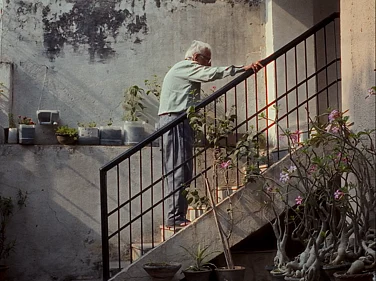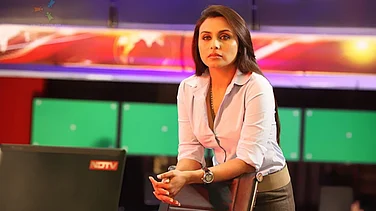The year was 2007 when, with an old dictaphone in hand, I decided to formally record the stories of my maternal grandfather, Ram Tipnis, the oldest living Hindi cinema make-up artist at the time. My vivid childhood memory is of him recounting experiences from his father’s travelling theatre company, his trips abroad, and the many stories of his life as a make-up artist from 1942 to 1995. While most children my age were listening to fairy tales, I had a front-row seat to the world of Hindi cinema. Stories of a dancing superstar of the 1960s driving down a narrow, hilly road at breakneck speed, swerving around perilous corners fuelled my evenings: edge-of-the-seat stuff for a nine-year-old!
The anecdotes were enlivened by trophies and memorabilia in my grandfather’s one-room-kitchen. From the Dharmendra starrer Jugnu was a figurine of the actor dangling from a chandelier by one arm; every time someone tried to dust it, Dharmendra pirouetted like a ballerina. Then there was the car-shaped souvenir from the film Brahmachari, which my brother broke in two. There were some black-and-white photographs as well such as those taken with Dilip Kumar during his 17 years at Filmistan Studio, and working stills from Shammi Kapoor’s films, for my grandfather had been Kapoor’s personal make-up artist for 20 years. The highlight of the collection was my mother’s wedding album that featured some of the biggest names of the 1960s: from Asha Parekh and Sadhana to Saira Banu—all of whom my grandfather had worked with closely for several years. The impetus for my project was a desire to gain insight into my legacy, and record the memories of a technician whose remarkable tales could someday become part of Indian film history. On the first day of my research in 2007, he said, “I don’t want to be an also-ran, I must be the hero of this.” A few years earlier, a film journalist had requested him for an interview for a special issue on technicians in the Hindi film industry. The title of the piece was They Also Served. My grandfather bluntly refused the invitation to ‘also serve’.
Ram Tipnis was born on 8th June, 1921 in Mahad, Maharashtra. He travelled with his father’s theatre company, Maharashtra Natak Mandali, till he was eight. When he finally enrolled in school, he was one of the oldest boys in his class. At 20, he started working in Pune as an Assistant Director to support his seven siblings and ageing parents. The reason was the arrival of cinema, especially the talkies. As he recalled, “The audiences were attracted to the talkies. In the cinema, they could see a variety of things. It was an exciting new medium to which people were drawn. My father’s company in its heyday did 30 shows a month; now he was reduced to doing only one show a month. They had 60-75 people on the payroll—actors, technicians, and their families. By the end of the 1930s, most theatre companies had shut down. It was a hard time for several theatre workers. Since I failed my matriculation, I decided to look for work in this new industry and support my family.”
After assisting on a few unsuccessful films, he was approached by Dada Paranjpe (who had quit Prabhat Studios with V Shantaram) to join him as a make-up artist in his new venture—Rajkamal Studio in Parel. Dada Paranjpe said: “I am getting to do a Leela Chitnis film in Bombay, why don’t you assist me?” My grandfather thought it was ‘a good prospect’ since he could stay at his uncle’s house. And so, on a salary of Rs 25, his tryst with Bombay began in 1941 as an assistant make-up artist on Keshavrao Date’s Kisi Se Na Kehana.
As soon as I turned on the dictaphone, my grandfather would clear his throat and start performing—his roots in theatre had made him a great raconteur. The scandalous affairs remained censored. Once the dictaphone was off, however, the most delicious gossip gushed forth. From the suspicious husband of a glamorous actress barging into her make-up room to the senior actor breaking the arms of two brothers simultaneously after a night of raucous drinking, he would regale us with these stories told ‘properly’—with love, grace and just the right amount of dramatic inflection.

He spoke of his years at Filmistan under the leadership of S Mukherjee and Rai Bahadur Chunilal with deep fondness: “There was no freelance system at the time. Even an actor like Dilip Kumar was paid a monthly salary like us. The 15th of every month was payday and Dilip Kumar would have to stand in the line just like the rest of us! I used to get paid Rs 500 per month.” My favourite anecdote has to do with his trips from Bandra to Filmistan, where Dilip Kumar would travel with my grandfather in a third-class compartment of a Bombay local train even though he’d had a first-class pass—just for the sake of good conversation and company.
For a make-up artist, the advent of colour film was no small challenge. Cinematographers, too, struggled with the new technology. As my grandfather recalled: “Gevacolor film was very thin and had a yellow tinge. Being very slow, it needed lots of 5 KW & 10 KW lights. If, while shooting, a 1 percent shadow was registered, after exposing the film, it would show up as a 10 percent shadow. So, to avoid shadows, people would use very bright lights. But we soon realised that due to the bright lights, the actors’ skin started burning and we needed to keep an ice box on set and use Chamois leather.”
During early experiments with Gevacolor, he added, a trial was conducted in 1954 for a song sequence with Vyjayanthimala for Nagin. “Fali Mistry was the cameraman. We saw it the next day and it had a lot of yellow in it. So, Mukherjee sahib (the producer) said, ‘Let’s change the make-up and bring Jimmy Vining (a British make-up artist who had worked on Kishore Sahu’s Mayurpankh). Because I really wanted to learn, I said, ‘Okay, no problem, let’s call him. On the third day, Fali sahib came to me and said, ‘Tipnis, we will do one more trial with Vyjayanthi ji.’ I told him, ‘But Mukherjee sahib has said we have to call Jimmy Vining.’”
“Fali sahib, gentleman that he was, said, ‘No need, it is not your fault. It’s my fault. I took a little piece of film and developed, printed and corrected it. The make-up you did yesterday was correct. Let anybody say anything, don’t listen to them. Just listen to me’. Do you know what happened? There was a lot of yellow in Gevacolor so then Fali sahib put filters and reduced it. From then onwards, we began to do pink make-up to reduce the yellow!”
My grandfather’s signature habit at Filmistan was adding ji after every actress’s name and appending sahib for the men. There was Sadhana ji, Asha ji, Shammi sahib, Mukherjee sahib, and the celebrated onscreen villain, Pran sahib and so on. The other technicians who were older or more experienced, he referred to as dada. The man who brought him to Bombay was Paranjpe dada. The sound recordist at Filmistan was Jagtap dada. These delicate hierarchies were perhaps linked to class and stature and not merely age or seniority. After the studios closed down and technicians became freelancers, these tacit protocols collapsed. He referred to younger stars such as Dharmendra, Sanjeev Kumar and Rajesh Khanna by their names.
During my research, I had accompanied my grandfather to meet two actors whom he idolised and had long associations with—Sadhana and Shammi Kapoor. Narrating an incident during the filming of Rajkumar that starred both of them, he said, “We were shooting a song where one of the boats had to float into the shot. The director called out, “Chalo!” and everyone, including Shammi sahib, rolled up their sleeves and pulled in the boat; that was the kind of camaraderie on set in those days.” At our meeting with Sadhana, the bonhomie was palpable; in fact, my grandfather hardly let her speak. Although I was mildly irritated, I also conceded that, perhaps for the first time, he was the centre of attention in her presence.
With Shammi Kapoor, the exchange was warm but sahib was clearly the hero. He gave us precisely 30 minutes, spoke briefly (when asked about the advent of the colour film: “I looked bloody good in black and white and I looked bloody good in colour”), offered us tea, and packed us off, but not before reciting a poem about himself written by Kamlesh Pandey.
My research gradually tapered to a close as I moved cities. A few years later, in 2011, my grandfather passed away, a month after we had celebrated his 90th birthday. Looking back, this project was a process of discovering hidden histories, of unknown cine workers and their undocumented careers. People like my grandfather gave their all to cinema—their labour, commitment, and passion. Today, when I see a Shammi Kapoor, Sadhana or Dilip Kumar film, I imagine Mr. Ram Tipnis on the periphery, engrossed in the shoot or engaged in banter with his colleagues while doing what he loved most—making other people look good.
(This appeared in the print edition as "A Brush With Stardust")
(Views expressed are personal)
The entire project is archived here www.papaajoba.blogspot.com
Anuja Ghosalkar is a performance maker and founder of drama queen, a documentary theatre company in Bangalore





















